
If the digital age has tried to teach us anything, it’s this:
Short is good.
Shorter is better.
You can see the “shrinkage” of digital media pretty much everywhere. Whether it’s on mobile devices, laptops or desktops, smart speakers or…even radios, consumers have precious little time or tolerance to sit through content that doesn’t initially grab them.
Yes, it’s true – many Super Bowl TV ads broke these rules, partially because the agencies that produce them get self-indulgent with monster budgets, and because if there’s any show where viewers aren’t going to start flipping around, it’s “The Big Game.”
On the other 364 nights of the year, it’s all about bringing people in early and not giving them a chance to grab that remote and start surfing. If you remember The Larry Sanders Show on HBO, a cynical parody of late night talk shows, the genial host (played by the late Gary Shandling) went into every commercial break with the command or plea:
NO FLIPPING!
For me, the initial lessons came from using Twitter, a platform that debuted in 2006. At the time, critics were mostly incredulous about the idea of somehow communicating meaningful messages using just 140 characters. Many blew it off as a gimmick – a way to gain attention to a social media concept that was patently absurd.
I hopped on in 2010 when I was invited to speak at a “140 Characters Conference” in Detroit that year. It seemed like a pretty good idea to familiarize myself with the social engine that inspired the conference. The event’s organizer, Jeff Pulver, took Twitter’s short staccato messaging to heart. His presentations were a mere 10 minutes long; the star presenters and panels were double that.
the conference. The event’s organizer, Jeff Pulver, took Twitter’s short staccato messaging to heart. His presentations were a mere 10 minutes long; the star presenters and panels were double that.
On paper, the agenda was loaded. When sessions are that short, you can cram a lot of them into a day or two. But as I discovered, you can cram a lot of information into a compact space if you prep, edit, rewrite, and then edit a bit more.
The event was emblematic of Twitter itself, and that’s why it was successful as Jeff and his team toured around the U.S. and overseas. Back then, you had to figure out how to create cogent, clever, compelling tweets with just those few characters. Later in 2017, Twitter doubled its capacity to 280 characters, where it is still at today. It’s nowhere near as challenging, and Twitter hasn’t grown much. In fact, its monthly users have plateaued.
 But the idea of communicating in shorter bursts is something perhaps we should have seen coming. Vine – a platform of 6 second videos – launched in 2012. It was acquired later that year by Twitter who obviously loved the idea of a video version of their short messaging site. While Vine was eventually shuttered, it spawned other short-form video plays.
But the idea of communicating in shorter bursts is something perhaps we should have seen coming. Vine – a platform of 6 second videos – launched in 2012. It was acquired later that year by Twitter who obviously loved the idea of a video version of their short messaging site. While Vine was eventually shuttered, it spawned other short-form video plays.
For some of us, Twitter helped prepare us for PPM, Nielsen’s methodology, adopted in the top 48 U.S. markets starting in 2008. If there was any doubt about the length of content in the diary days, PPM confirmed that listener attention spans were shrinking. Unless you were a great storyteller, chances are there was a program director in your ear reminding you to keep it brief.
The term “mic flight” was bandied about during the period as well – the idea being that when a DJ starting talking, those meters migrated somewhere else. Of course, that turned out to be a gross generalization, and ultimately, not great for radio’s personality quotient. But in the early years of PPM, tight was right.
Meanwhile, Vine’s demise didn’t stop other platforms from experimenting with short-form content – especially video. But these mini-vids did not truly take off until TikTok broke out in 2017, and accelerated during the pandemic. Remember that President Trump came close to banning the platform in the U.S. in an ongoing dispute with China.
Today, TikTok’s 60-second videos have become the industry standard, attracting more than a billion users last year, meteoric growth for a platform that (once again) many mocked and joked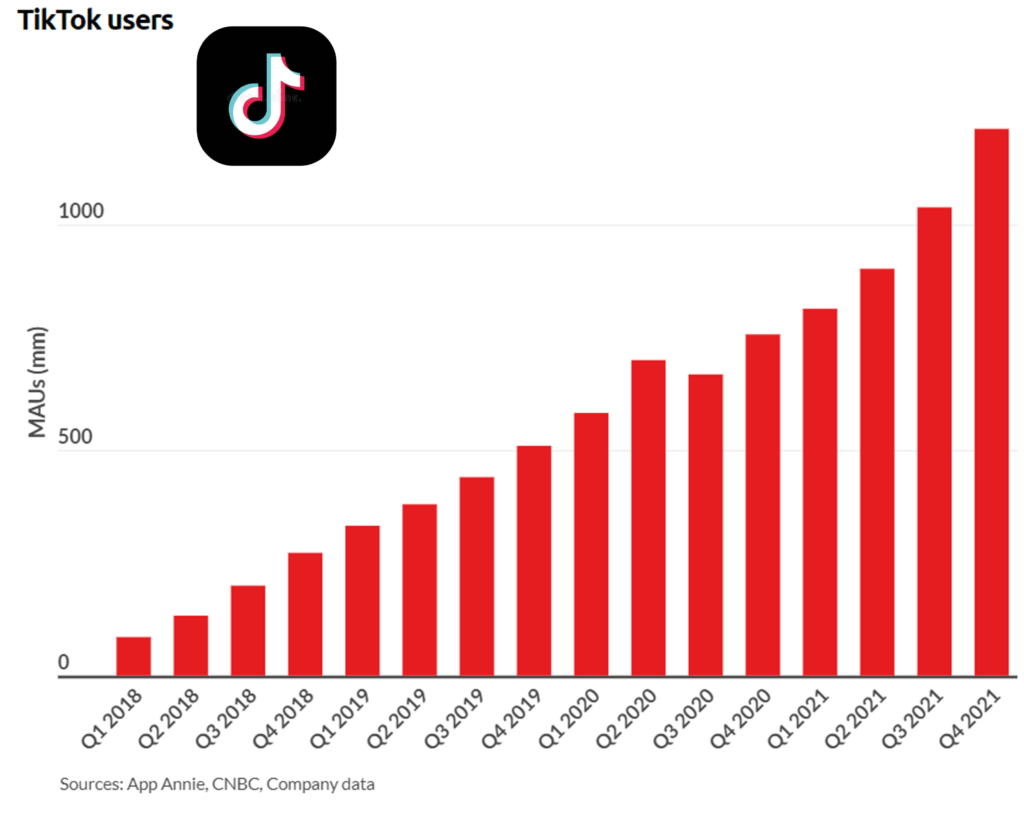 about. The chart at right from App Annie and CNBC shows a growth curve that most of us content creators can only dream about.
about. The chart at right from App Annie and CNBC shows a growth curve that most of us content creators can only dream about.
Today, new music, fashions, and other trends break on TikTok. In short, it’s a powerful marketing tool, and the company supports the platform with resources designed to help advertisers move product.
A case in point is a story in Social Media Today that links to TikTok’s guide to helping automakers and dealers sell cars. Their “Auto Playbook 101” is just one of several TikTok guides for marketers seeking to maximize the platform. It’s an especially great example of how short-form videos can be effective marketing tools.
And the meteoric rise of TikTok has other “legacy” social platforms playing catchup. Last summer, I wrote about a seismic strategic shift at Instagram where the emphasis is now on short videos rather than photos. Adam Mossseri, the company’s head, described the pivot in unequivocal terms:
“We’re no longer a photo-sharing app or a square photo-sharing-app.”
That’s right. Instagram had better double-down on short videos or it will feel the heat from TikTok, as well as the ever-popular YouTube.
And that leads us to recognizing a new shift at Google-owned YouTube, yet another sign short-form video isn’t just a fad – it’s a trend.
Last week, Andrew Hutchinson, Social Media Today’s content and social media manager, wrote about YouTube’s next move. They’ve added their Shorts clips – yes, their version of quickie videos – to their YouTube channel pages.
Hutchinson’s example is framed below in red:
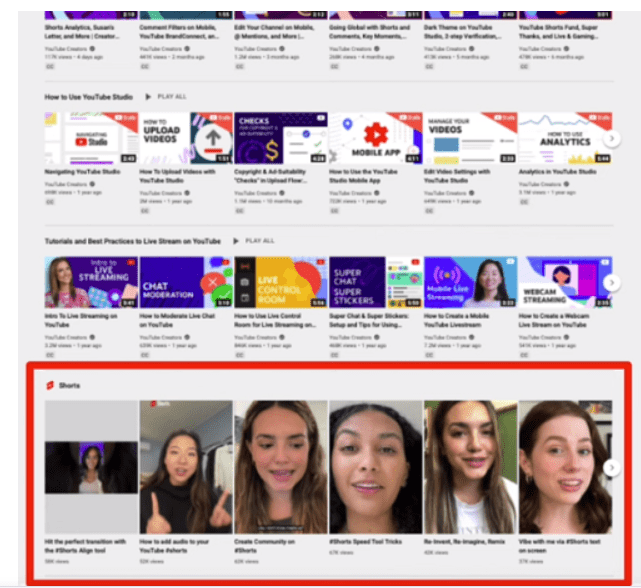
Moving forward, each channel will display their Shorts clips, making them easier to recognize and access. And why not? YouTube says Shorts have hit the 5 trillion views mark.
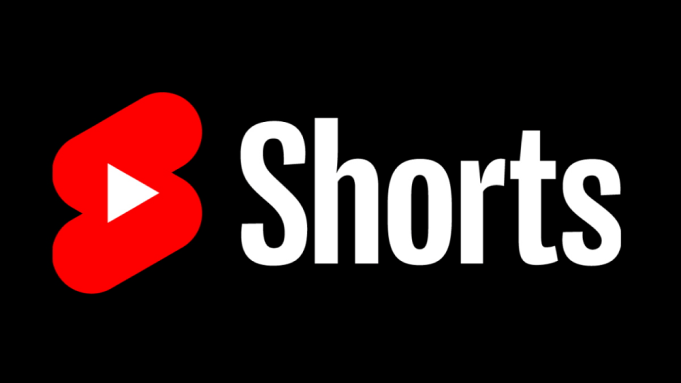 By making Shorts more visible, YouTube is leaning into the short-form video format. Interestingly, they’re not launching a standalone Short app, but instead are making these videos a part of their main channel. In this way, the Shorts brand is incorporated in the mothership – the YouTube channel.
By making Shorts more visible, YouTube is leaning into the short-form video format. Interestingly, they’re not launching a standalone Short app, but instead are making these videos a part of their main channel. In this way, the Shorts brand is incorporated in the mothership – the YouTube channel.
All of this points to the outsized influence short videos are having in the social space. And that leads into the concept that more radio stations and their companies should be reading these obvious tea leaves, and working on short-form video solutions that can live in any number of places. To that end, that can be shared widely, whether it’s the email database, social pages, and other outlets.
While no one in the radio broadcasting industry has the numbers to back it up, I can tell you I keep running into situations where videographers are either being hired or are already in position to create and drive content that can build brands, as well as drive the sales marketing effort. Imagine a strong air personality who has these skills – hard to beat.
Finally, you may be wondering about the one content silo seemingly oblivious to all this talk that “shorter is better.”
Of course, I’m talking podcasts, a medium that has basked in the glow of not having to care about duration, attention spans, and other such trivialities. After all, podcasts are limitless – they can be as long as a producer chooses to make them.
Except that focused on these short-form videos, podcast duration has slowly but surely shrunk.
When you ask most podcasters about the uncomfortable topic of length (after all, we talking about an art form here), they’ll point to Dan Carlin’s Hardcore History podcasts which average three hours and 39 minutes in length. They are brilliant – ask any historian. I sampled one of Carlin’s podcasts a few years ago, and they truly are riveting. As a former history major, I respect the ability to take inherently dry material and breathe life into it. Problem is, you could play 18 holes of golf in the average duration of a Hardcore History episode.
hours and 39 minutes in length. They are brilliant – ask any historian. I sampled one of Carlin’s podcasts a few years ago, and they truly are riveting. As a former history major, I respect the ability to take inherently dry material and breathe life into it. Problem is, you could play 18 holes of golf in the average duration of a Hardcore History episode.
But Carlin isn’t typical of podcasts, any more than WTOP is an average All-News station, or public radio programs are run-of-the mill. They’re unicorns, one-offs, anomalies. Unless we’re retired, on vacation, or a history student of buff, there’s almost no excuse for a podcast that runs this long.
Most podcasts don’t love discussing this topic, but the fact is, titles launched in recent years are actually shorter. While more than half of podcasts launched in 2014 were at least one hour long, fewer and fewer take that much time to plow through.
In fact, the chart below depicts that perhaps even organically, newer podcasts run shorter – at least the most popular ones. Megaphone’s Luke Riley broke this down in 2019, tracking Apple’s Top 200 podcasts – by length. Here’s what he learned:
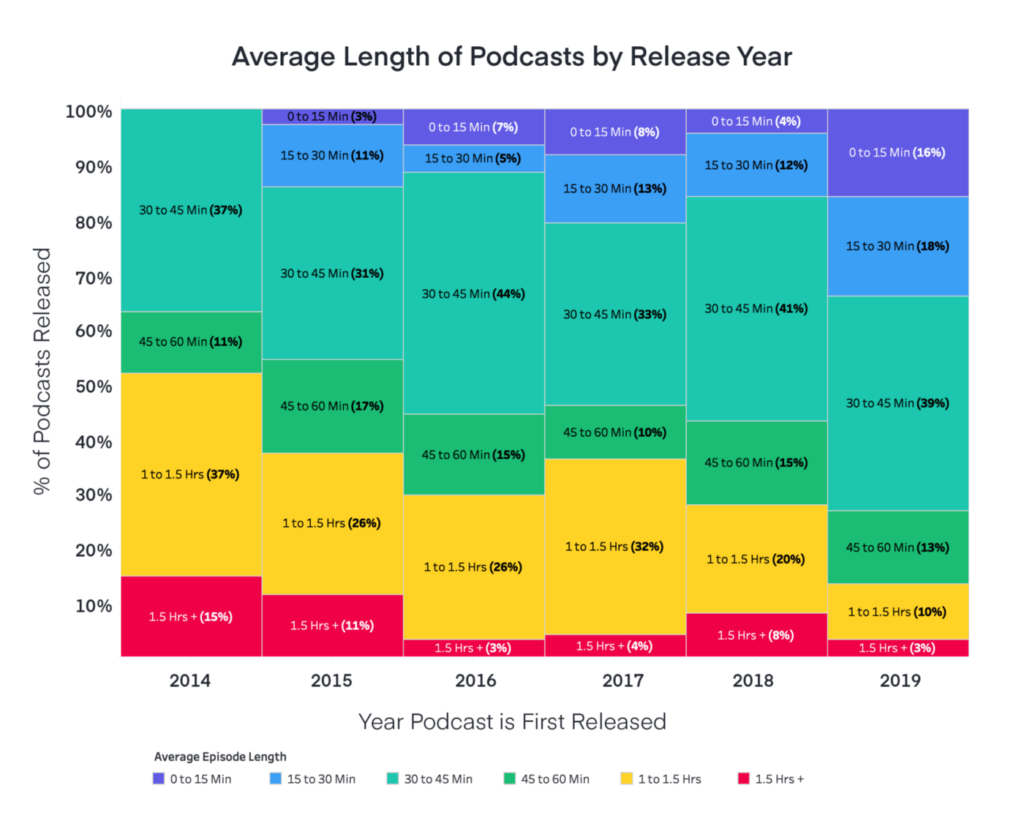
Note that in the most recent year charted, nearly nine in ten podcasts were under one hour in length, a major shift from just five years earlier.
But what about post-pandemic? How long should podcasts be in 2021? Jennay Horn took on that topic in an article published last year in We Edit Podcasts.
After digging into the topic, she ran into a key stat from Pacific Content’s Head of Audience Development, Dan Misener. In 2019, he calculated the average podcast that year was 41:31. The previous year’s average was more than two minutes longer.
Applying that trend to subsequent years (yes, a bit of a leap), Jennay predicts the average podcast in 2021 was in the neighborhood of 37:30.
The question is, how long does it take to tell a good story? Twitter, Vine, Snapchat and now TikTok have been tackling that question over the past several years. In podcasting, that learning has come more slowly, but the trend toward “compactness” is unmistakable.
The fact is, stories can be told in less time. Dan Carlin’s mammoth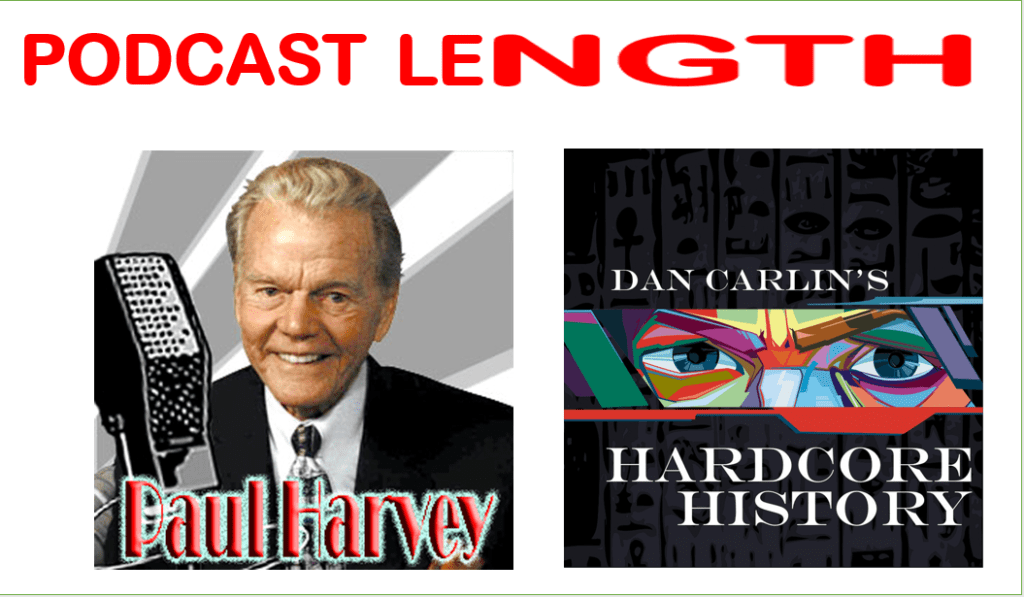 podcasts may be on one extreme. Radio legend Paul Harvey’s “The Rest of the Story” features incredible tales (and great teasing) in packages just under four minutes in length. They would have made great podcasts – and highly profitable ones.
podcasts may be on one extreme. Radio legend Paul Harvey’s “The Rest of the Story” features incredible tales (and great teasing) in packages just under four minutes in length. They would have made great podcasts – and highly profitable ones.
How might shorter podcasts revolutionize the podcasting industry?
- Shorter podcasts are less expensive to produce.
- Longer podcasts could be edited to create more episodes = more avails = more revenue.
- Given the indisputable trends, shorter podcasts would inevitably lead to more listening.
- Finally, brevity might lead to trial. That is, how much would listeners be encouraged to sample a podcast if they knew it was, say, 15 minutes long?
The fact is, Twitter, Vine, PPM, TikTok and just plain common sense teach us the more we streamline and edit most content (note I didn’t say all content), the better it often turns out.
Shorter isn’t always better. I’m sure Dan Carlin, Howard Stern, Peter Jackson (director of The Beatles: Get Back), Leo Tolstoy (War and Peace) and other brilliant content creators would effectively make that case.
But for most of us, the tighter we keep it, the better off we are. I would never encourage the creative types to edit to a certain length – hell, this blog post is more than 1,800 words long. But the quest for so-called “snackable, bite-sized content” pushes us to think about how we can deliver more in less time.
The trends are clear.
It’s amazing the stories that can be told in so little time:
@zachking⚠️ Caution wet paint. Who watched until the end??♬ original sound – Zach King
And here’s a handful of Paul Harvey’s “The Rest of the Story” features, for those of you who remember them and those of you who have never heard them:
https://www.youtube.com/watch?v=r2KcbE4cBRo&list=RDr2KcbE4cBRo&start_radio=1&rv=r2KcbE4cBRo&t=0
- Media And Technology In 2025: Believe It Or Not! - April 18, 2025
- In Radio, You Just Never Know - April 17, 2025
- The Secret To Making A Great Podcast (And Great Radio) - April 16, 2025




Agreed. And, as a major Beatles fan, I thought almost 8 hours was too long…waiting for the 4 hour edit!
Glenn, it could have easily been a 6-parter. Or just edited down. I watch the first installment with a number of family members, some of whom were lukewarm Beatles fans, but eager to see what the doc was all about. At various points, I felt like apologizing because it was so repetitive. A great concept, of course, with beautiful footage, but it most certainly dragged.
The directors of radionotas.com, the portal where I write my articles on radio, told me that I should write short articles because the Millennials, to whom the portal is focused, want short and fast reading content.
Unfortunately, I have very little power of synthesis, and my articles are longer than the average of those published there.
However, my writings generally have many more visits than those of the other editors of that portal. I guess that’s because I try to keep the content interesting, carefully crafted, and entertaining.
But also because in my articles I usually tell personal anecdotes related to the topics I present, which creates a closer emotional connection than a simple radio lecture.
How long does it take to tell a good story? Whatever is needed. No more, no less.
You’re right, of course, Tito. It’s all in the messaging and how you deliver it. Like the conversations we’ve been having about the blog this week, when you have a relationship with an audience (a community), and they trust you, you’ve got more poetic license to go long, take a side trip, etc. You’ve just got to pay off. Thanks for this comment, and your last line is 100% truth.
A few years back I started my podcast with that very thought in mind-keep it short with lots of changing content. As a comedy podcast, I always keep each episode of “Live From Crapper Creek Alaska” to under 35 minutes and each is filled with short segments, interviews, bits etc -each of which is no longer than a few minutes so it moves quickly with sweepers in between. Much like i do my radio show on 95DOT9 XROCK. and doing it from a cabin in Crapper Creek Alaska on the worlds farthest north rock station-gives me great click bate. This was a great article, thank you
GLen, appreciate this. Glad you enjoyed the post and thanks for the comment.
=Read the 14 seconds=
Listening and attention levels went to hell when kids started watching Laugh In and Sesame Street. An’ we wonder why gnats have longer attention spans than some humans. Get off my lawn, dammit! Another block of the Doors comin’ up … right after this nine minute commercial break. Ahem.
~~~
Respectfully submitted 😎
Well, there’s that. The price of “free radio.”
LOVED Paul Harvey growing up!! Nobody did it better. Thanks for sharing, Fred, and of course……………GOOD DAY!
Page 2! Thank you, David.
Of course you’re right Fred. The trend is clear.
I’ve spent about an hour trying to compose what your fine, long-ish, piece of prose brought up for me, but what I wrote is too long and winding. It was, though, filled with honesty and ambivalence. You know, an authentic, muddled human response.
So I’m scrapping most of it to say, perhaps more tightly, that yes – podcasts probably should be shorter. It’s usually just hosts being lazy…frankly NOT respecting the time investment of their audiences. That respect would be more on display with a judicious edit before hitting the “publish” button.
And I have to take exception to your bullet point that shorter podcasts would be less expensive to produce. Tightening focus of a media discussion in real time or editing it in post-production, means you are going to have to invest either in more skilled people hosting the conversation or more time and resources to edit it later to make short actually good.
And I wrote much more about this next point that I’ve deleted but… I’m not too sold on ramping up the efforts to generate MORE super-short audio/video/text content even more quickly, so we can stack up more frantic messaging efforts at our prospective targets – making incomplete guttural impressions to run up engagement numbers. Just because it works doesn’t mean it serves the public good. Personally, I don’t want to be part of further enabling the shrinking of humans’ attention spans even further just for profit. I think doing so contributes big-time to a BIG cost — an uptick in a society’s anxiety, and a down-tick in its inability to really understand anything deeply. The more short messages we throw at people, the more they come to expect easy answers and instant solutions to complex problems, to match the quick satisfaction-laugh they got out of a 40 second TikTok video.
The result? Our population deals with monkey-mind ALL the time and feels no power to really understand their world.
Now I’m not opposed to the judicious edit. I spend most of my time every day working on judicious edits of my own radio work (usually from WAY too long to just LONG in most people’s judgement) But, to me, every 20 seconds of any spoken (or sung or played in the case of music programming) content has to be judged by curators to have high value, adding to the uber-mission of sharing some worthwhile part of the human experience for listeners/viewers to take in.
I know you aren’t advocating the ban on all longer-form content. I think you’re saying leave it on public radio and PBS or art house theaters or streaming services for more patient people to find it, and pay for it, if they want it… or more precisely for YOU to find when YOU need it Fred – as I know you must still do. I think you’re just saying add the value of the “short” trend to your overall outreach tool kit. I have to admit to doing that myself. I may produce a 2-hour Beatles history radio show, but I offer a one-hour edit for stations that won’t give me two hours, AND a 10 minute featurette for those that won’t give me even the hour.
And I DO agree that there IS brilliant quick-time content – a Paul Harvey script, a great SNL commercial parody, a tight AND thoughtful editorial, a concise but nutritious, well delivered bit of DJ banter before or after a song. Maybe that’s most of what you are advocating for in this column.
But let’s frame this editing argument as a call for putting MORE thought into our communication, rather than just making it SHORT-SHORTS, just because each successive generation has become bored more quickly and we really want those numbers in our column.
Pretty long post even in edited form. And yes, it took me longer to edit it! I’m now 100 minutes into the effort… got to get back to work on editing my next show for radio.
Thanks for stirring me up pal.
Well, it looks like I can still get to you, my friend. My generalization on length was just that. There is wonderful long-form content in many, many places that is worthy of extended time and attention. As you note, public radio/TV is famous for providing us with long-form perspective. Same with the New Yorker and The Atlantic.
It’s all those hour-long podcasts where they spend the first 5 minutes screwing around that will go the way of the stegosaurus. Great content knows no bounds. That’s a fact. (See – I said it in less time than YOU did. 🙂 ). Thanks as always for your wonderful “takes” on my stuff.
Yes on lazy podcast meanderers. Every line should have a considered purpose.
And, for the record, I like to be stirred up and challenged to pull cogent thoughts out of my head and onto the page by you. You doing it most every day is an inspirational commitment.
Stay well and you just keep thinkin’ Butch… that’s what you’re good at….
https://www.youtube.com/watch?v=cHT0qUpLxMI
Back at you, Kid. Just trying to stay on my horse.
We ran Paul Harvey on our AOR station in Nashville back in the late 70s & early 80s. Not sure WHY it worked… it just worked. The 18-34 southern long-hairs ate it up. The four minutes were just short enough for the feature to really stand out from our music, but hopefully not lose anybody along the way (although I believe the midday report was more like 12 minutes). It never hurt our numbers, though. “This is Paul Harvey…. stand by for NEWS!”
Fred, that was WKDF, and I remember competing against you guys across the street at WGFX. You were the only rock station in the country – and on the planet – carrying Paul Harvey. And you might it work. I remember doing research and your audience thought it fit the station as much as Zeppelin and Skynyrd. I remember at the time thinking this was a textbook lesson about the uniqueness of local brands. It was a great reminder why all rock stations SHOULDN’T sound the same. Thanks for that memory and for the comment.